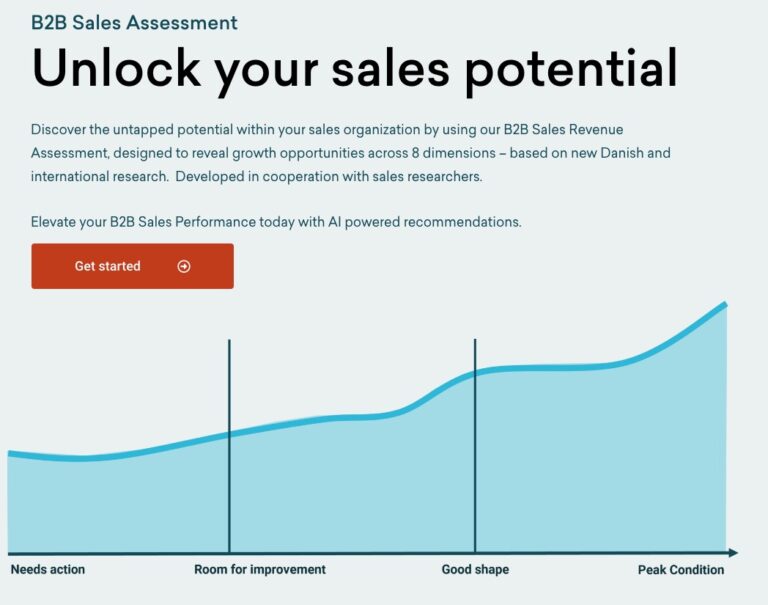Sales is not ‘just’ sales!
One can be tempted to see sales as a rather uncomplicated discipline. That sales is easy, just as salespeople are extrovert, competitive people with good human qualities and perhaps a portion of audacity. But research demonstrates that sales and sales management require a much more tactical approach, so the question is: Do you do the right thing?
Michael Kaalby Mortensen

Sales does not always equal sales! There are a multitude of known sales methods – actually over 200 different! A sales method covers the fully described concepts of sales. They have different characteristics and target different sales situations. You can compare them with game styles in soccer: Some teams play very ball-controlling, while others focus on defensive tactics with fast counter attacks. Others again play with high pressure all over the pitch, etc. Soccer coaches are very conscious of the choice of playing style – for example, based on a philosophy of how they will play. Other coaches adapt their team’s playing style to the opponent, and finally there are those who choose playing style based on what suits the player material they have available in the team.
Choose the right method
The same goes for sales methods. The different methods fit specific sales situations, but have you made a conscious choice about your style of play/sales method? The best-known selling methods include Persuasive Selling, the SPIN method, Value Based Selling, Challenger Selling or Insight Based Selling and Co-Creation sales. Don’t worry – we’ll elaborate on them here.
But before taking a deep dive into sales methods, we need to put sales into perspective. Deciding sales methods is like deciding a strategy, so we need look at the context and know the sales dynamics of our business. And to make it very simple, look at the left and the right-side on the axis below.
On the left-most side we have transactional selling. It’s the kind of sales that is relatively quick, can be done online and is simply based on a transaction of product/service and payment. It’s a very common kind of selling – and there’s nothing is wrong with that. But it demands a certain skill- and mindset. Often this kind of sales is driven by activity and budgets to reach.
Opposite on the right-most side we have interactional selling. In this kind of selling we partner up – maybe even with competitors and suppliers – to solve something big, bigger than simple budget goals. We look at the bigger purpose.. We are focused more on client relationship and dialogue.
The mindset on the right-hand side is long-term budget and more on development than fast selling. I think you can now imagine what happens if this is not aligned.
So let’s take a look of some of the sales methods.

Persuasive Selling
In Persuasive Selling, the seller attempts to convince the customer of the value of the product or solution and few questions are asked from the seller to the customer. There is a low degree of value adding and therefore this type of sales is increasingly moving into online sales.
SPIN Method:
The SPIN method is always problem-focused (it actually derives from therapy). The question technique in the SPIN is based on the four sequences Situation, Problem, Implication and Need-pay off. Here, it’s about strengthening the customer’s experience of the problem, so the need to find a solution (i.e. make a buying decision) together with the sales rep is reinforced.
Value Based Selling:
Value Based Selling is characterized by the customer being helped to find a solution to the needs of the customer. The questions the seller asks are focused on making visible the value that the product creates for the customer.
Challenger Selling:
In Challenger Selling (or Insight Based Selling) the seller provides challenging insights and insightful ‘distractions’ that give the customer a new perspective on his or her own industry or business – and this can help to develop the customer.
Co-Creation Sale:
In Co-Creation sales, the customer is active throughout the process. There are no known solutions in advance, and sales are made through interaction, where new ideas and opportunities emerge in the creative innovation process. The conversation is characterized by dialogue, and the question type is characterized by future-oriented, curious questions.
In Intenz, it’s our experience that very few sales organizations and sales managers have made a conscious choice about which sales method and communication their salespeople should use. What about your sales organization? Have you chosen your sales method? And how?

Are salespeople and management aligned?
If you have not chosen a method, the consequence is often that your salesforce sells in a way that is not optimal in terms of the sales situation they are in. They simply choose a wrong selling method and way of communicating – or rather they don’t choose, they just ‘do’ sales, as Karina Burgdorff, PhD student at Aalborg University, expresses it. The point is that we need to be much more aware of what we’re doing and what we would like when we sell. For example, too often we see that sales management wants their salespeople to be advisory or consultative in their sales. However, salespeople are effectively conducting ‘Persuasion Selling’ and are using all their time with the clients to describe products and services in the hope that they can convince the client to make a purchase.
Often, neither salespeople nor sales managers are aware of this behavior and the lack of alignment with the sales management. Karina Burgdorff’s research shows that sales organizations improve their turnover by a minimum of 8% by deliberately changing specific areas of sales. It is the sales organizations that have formulated what they believe in the sale – their sales philosophy – and which, based on it, have created alignment between sales philosophy, sales method and sales communications of sellers. There is therefore huge gains from being more targeted in the sales work and in the choice of sales method. At the same time, it’s worth highlighting that the research shows that sellers can master a maximum of two sales methods – so it’s smart to be aware of what you need to be able to do.
A job that pays off
Most sales organizations have divided the salespeople into districts – typically from geography. In addition, they have created a KAM department for big client sales, a reseller sales team if sold to retailers and they have a client service team that receives orders on the phone. It’s a good start, but consider going one step further and analyze which sales methods and communicative techniques are right for your different sales situations and client segments. Because it’s not just the sellers that need to be developed. The different sales receipts also require different sales management. For example, Short-term sales targets do not align well with Co-Creation sales, because in this approach there is a need for a completely different and more long-term focus. It’s also crucial that you look closely at the skills of the sellers, so their way of selling and communicating matches your sales philosophy and methodology. Does it sound challenging?
Some questions you should consider:
- Have you defined what you believe in for the sale experience – the sales philosophy?
- Do you focus on which sales method you want to use?
- Have you arranged for alignment in the sales organisation?
- Do you know how many different types of sales situations your salespeople should be able to handle? (And are there too many…?)
- Do you know what skills it requires the sellers to have? And how to obtain them?
- And do you know what kind of sales management it takes to get the sales philosophy to ‘live’ in the sales work?


